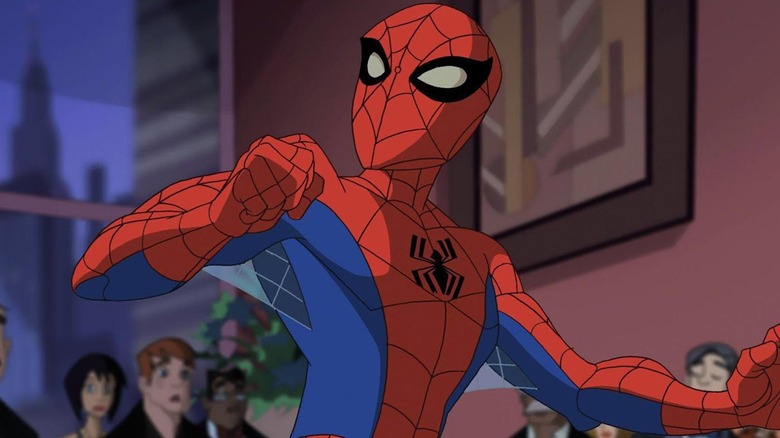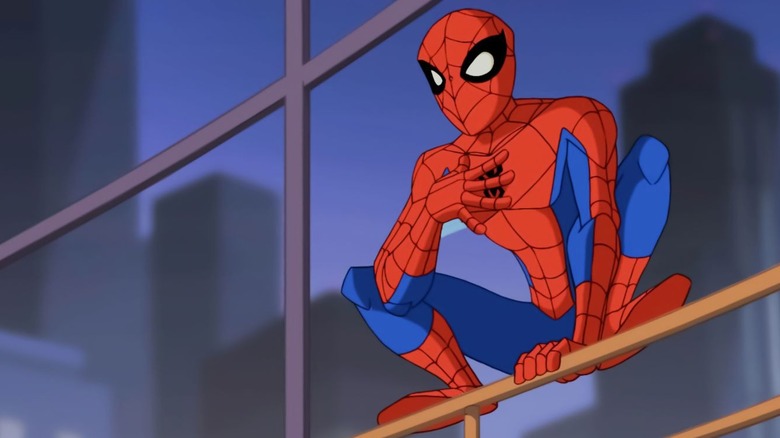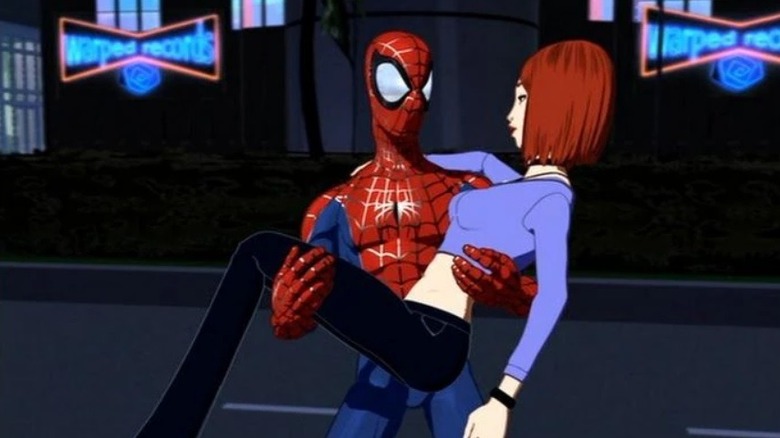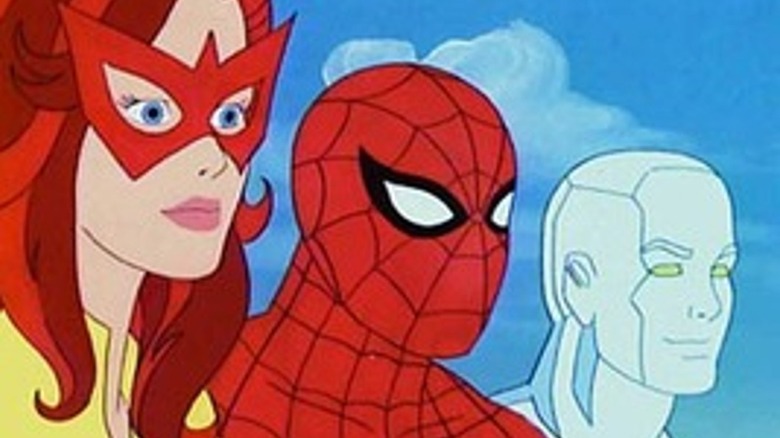The Correct Order In Which To Watch Every Spider-Man Animated Series
There's no shortage of animated series based on Spider-Man's adventures. In fact, it was only five years after his comic book debut in "Amazing Fantasy" #15 that he received his own eponymous cartoon in 1967. Since then, Spidey has become a comic book hero with a consistent presence on our screens — big and small.
With a plethora of shows about him, it can be overwhelming trying to figure out the correct order in which to watch them all. While you can start from the oldest series and work your way up to the latest one, there is a better way of doing it. The shows can all be divided into four basic categories: The first involves the early years of the young Spidey as he deals with his new-found powers. The second follows a more established hero as he navigates the next phase of his crime-fighting career. The third is a continuity of Sam Raimi's film universe. And finally, there are the shows that pair Spidey with other heroes and feature more team-up action. So, let's swing into it and sort out the correct order in which to watch every Spider-Man animated series.
Spider-Man (2017)
Comic book canon is about as consistent as the number of fries in a McDonald's order. Similarly, Spider-Man has also experienced several tweaks and retcons to his history since the '60s, and his backstory is plagued with inconsistencies. The basics of Peter Parker being bitten by a radioactive spider and Uncle Ben getting shot are non-negotiables in almost every iteration of the story, but everything else after that is up for debate.
In 2017, "Robot Chicken" writer and creative Kevin Shinick tackled "Spider-Man" as a showrunner. Shinick had been no stranger to the character, having written and directed the 2002 "Spider-Man Live!" theater production. For the new series, however, he didn't pull from simply one version of the character's history. He includes Miles Morales and Gwen Stacy as heroes and friends alongside the 16-year-old Peter who has just gained his powers while setting the backdrop of the story at Horizon High. The reason for this approach is he wanted to focus the show on Peter's love for science and how it shapes his life.
"It's my entry point for this series because it's about Spider-Man, but Spider-Man is Peter Parker, and it's his heart and his mind that we really associate with," Shinick told Collider. "Science is his passion, it's his entry point for everything, from talking to his friends, to dealing with a homework problem, or dealing with a supervillain; science is his go-to." The show aired for three seasons from 2017 to 2020.
The Spectacular Spider-Man (2008)
For many fans, "The Spectacular Spider-Man" is considered the G.O.A.T. — both in terms of Spidey's small screen escapades and generally in superhero animation. Much like 2017's "Spider-Man," the show centers around 16-year-old Peter Parker having recently received his powers, while also trying to navigate the trials and tribulations of high school and his teenage problems. Supporting Peter here are the likes of Mary Jane Watson, Gwen Stacy, Harry Osborn, and Eddie Brock, while Tombstone is positioned as the big bad of the show.
Speaking at the 2007 San Diego Comic-Con International (via IGN), co-showrunner Greg Weisman explained how this animated series was always intended to be an origin story and is set four months after Uncle Ben's passing. Weisman revealed that it was about "starting from the beginning, and not skipping over the formative years," as Peter learns the necessary skills he needs to become Spider-Man.
Unfortunately, the show only ran for two seasons from 2008 to 2009, and fans have clamored for a revival of the series ever since then — or a third season at the minimum. It's unsurprising considering how "The Spectacular Spider-Man" holds a 100% critical approval rating and 96% audience score on Rotten Tomatoes. At least fans were able to see this version of the character return in "Spider-Man: Across the Spider-Verse," where he is once again voiced by the original voice actor Josh Keaton.
Spider-Man (1967)
"Spider-Man, Spider-Man, does whatever a spider can ..." Everyone owes the 1967 Spidey animated series a debt of gratitude for birthing this legendary theme song. Not only has this track become synonymous with the hero and appeared in various iterations since then — including a fantastic rendition by the Ramones — but it has even become part of a greater gag in the form of Spider-Pig who appeared in "The Simpsons Movie."
Speaking of humor, this show has provided countless memes to the internet community, such as the infamous Spider-Men pointing at each other and Spider-Man lying in a hospital bed in full costume. Thanks to the dated animation, some scenes are unintentionally hilarious given the right text and creative mindset.
In terms of storyline, this series takes place during Peter Parker's stint as a photographer for the Daily Bugle. While he tries to get the right snaps for the ever-impatient curmudgeon known as J. Jonah Jameson, he needs to contend with the villain of the week who has some harebrained scheme. The first season features two segments per episode, while the second season goes to a single adventure per episode. The third season is a bit stranger as it shines the light on peculiar monsters and other non-canon Spidey characters. The reason for this change-up? The animators borrowed stock footage from another show "Rocket Robin Hood."
Spider-Man (1981)
Airing for 26 episodes across a singular season, 1981's "Spider-Man" animated series is often forgotten alongside the more celebrated adaptations of the superhero. That being said, its early '80s-style animation and campy nature add a certain charm to the episodes. It's very much a product of its time, but that's okay in the context of what it is and what it was trying to achieve. One thing that deserves special mention here is how incredibly faithful and detailed the character's costume is, showcasing how the animators refused to cut corners on the design.
In this show, Peter Parker is a young adult who is studying at college, juggling a job at the Daily Bugle, looking after his elderly Aunt May, and fighting crime, of course. Much like other shows of the era, episodes can be watched out of order since there is no real overarching story — it's all about Spider-Man chasing off a different bad guy. Unfortunately, Spidey was unable to punch the villains in the face here, since this program aired in a strange time when parent groups thought a clenched fist would summon the horned one from the depths of Hell and kickstart the apocalypse ... or something like that anyway.
What's particularly impressive about "Spider-Man" is how it traverses the Marvel Universe to give Spidey more villains — such as Magneto and Red Skull — in addition to his regular rogues' gallery. There are also appearances from other heroes, such as Captain America and Ka-Zar, but this is still predominantly about the web-slinger.
Spider-Man (1994)
When it comes to choosing the complete "Spider-Man" series, the 1994 animated show is arguably one of the best around. It dropped in an era where Marvel properties, such as "X-Men: The Animated Series," "Iron Man," and "Fantastic Four," all had their own programs and it felt like everything was somewhat connected — think of it as the prototype of the Marvel Cinematic Universe. In fact, there was even a crossover special between Spidey and Professor X's Children of the Atom, while other characters such as Ghost Rider, Daredevil, and the Punisher also cameoed on the show.
In "Spider-Man," Peter Parker is already a college student and trying to manage the expectations of his professors along with his love life, friendships, and duties as a costumed superhero and photographer for the Daily Bugle. It also marked the first time that a web-head series had an overarching plot, as continuity exists across all the episodes throughout the five seasons.
The show also manages to successfully adapt popular storylines from the comics, such as "The Clone Saga" and "The Symbiote Saga." In some cases, it does a better storytelling job than the source material since it uncomplicates the convoluted mythos and delivers an easier-to-understand version of the tale. Also, it must be said that it never gets old to hear Hank Azaria as Eddie Brock/Venom and Ed Asner as J. Jonah Jameson.
Spider-Man Unlimited (1999)
Without a shadow of a doubt, 1999's "Spider-Man Unlimited" is the most ambitious of all the animated series released. It's a soft reboot of the 1994 animated show, with Rino Romano replacing Christopher Daniel Barnes as the voice of the titular hero. Also, this Spidey receives a snazzy new set of threads reminiscent of Spider-Man 2099. The show is set on another planet called Counter-Earth where Venom and Carnage serve as the baddies alongside the High Evolutionary — whom many MCU fans will recognize as the despicable foe who destroyed Teefs, Floor, and Lylla in "Guardians of the Galaxy Vol. 3."
Interestingly enough, this series deviated drastically from creator Will Meugniot's original pitch. "We started out to do a low budget, but dead on faithful, adaptation of the first two years of 'The Amazing Spider-Man' comic book," he wrote on his blog. Unfortunately, there was a problem: Marvel had sold the film and animation rights of the character to Sony, but Fox still needed a show. There was some convoluted agreement between the different parties where Meugniot was allowed to create a "Spider-Man" show, but without using what is effectively the 'real' Spidey. It was then that Marvel suggested Counter-Earth as the location for the series and a list of possible characters to be used for this adaptation.
In the end, "Spider-Man Unlimited" only lasted for 13 episodes before flying into the sun and never returning.
Spider-Man: The New Animated Series (2003)
There's no doubt that Sam Raimi's "Spider-Man" reinvigorated the character for a new generation of audiences. To this day, Tobey Maguire's version of the wall-crawler remains a fan-favorite iteration — as proven by the response to his triumphant return in "Spider-Man: No Way Home." What most people don't know is there was an animated program set in the continuity of the Raimi-Verse. "Spider-Man: The New Animated Series" debuted on MTV in 2003, instantly catching the eye with its CGI animation style. It also boasted an outstanding voice cast including Neil Patrick Harris as the voice of Spidey and the late Michael Clarke Duncan returning to voice the Kingpin, the character he portrayed in the 2003 "Daredevil" movie.
The original plan for the show was for it to be an adaptation of the "Ultimate Spider-Man" comic book series. However, this pivoted into a continuation of Raimi's film universe, focusing on the unique and complicated dynamic between Peter Parker, Mary Jane Watson, and Harry Osborn after the events of the first movie.
Unfortunately, "Spider-Man: The New Animated Series" got canned after 13 episodes. Director Brandon Vietti admitted to The Marvel Animation Age that the cancellation caught everyone off guard. "I don't think any of us were ready to give it up so quickly," he said. "We had a really unique show going and we all knew it. Like most shows, I think it would have just kept getting better as it progressed."
Spider-Man and His Amazing Friends (1981)
Unlike a lot of popular heroes such as Captain America and Batman, Spider-Man doesn't really indulge in the sidekick scene that much. He tends to work on his own, only teaming up with others such as the Avengers or Fantastic Four when the need arises. Considering how group projects almost always fall apart or result in bitterness between individuals, who can blame him?
In 1981, "Spider-Man and His Amazing Friends" decided to change this dynamic. Rather than leave Peter Parker on his own, the series pairs him with two unexpected allies: Iceman and Firestar. It is a bit of a head-scratcher since Iceman is more known for his affiliation with the X-Men, while Firestar is a newly created character for the show. However, the latter was only conceptualized because there were issues around using the Human Torch from the Fantastic Four, who oddly enough does have a closer relationship to Spidey in the comics than these other two.
Speaking to Animation Magazine, story artist Rick Hoberg explained where the decision to create this team-up series came from. "NBC, when they were coming up with the 'Spider-Man' show, wanted to emulate 'Super Friends.' They needed a 'Super Friends' because ABC was doing very well with it and it had been on for many years." Hoberg added how the creative team avoided most of the camp of the DC series intentionally and focused on the dramatic side of superhero stories for the most part.
Spidey and His Amazing Friends (2021)
No, this isn't an editorial oversight. There is a 2021 series called "Spidey and His Amazing Friends," which does sound an awful lot like 1981's "Spider-Man and His Amazing Friends." Aimed more at younger viewers, this vivid and colorful animated series pairs Peter Parker, Miles Morales, and Gwen Stacy in team-up adventures as they battle a host of baddies such as Rhino, Doc Ock, and Electro. In the show, Peter uses the Spidey alias, while Miles utilizes the codename of Spin and Gwen is known as Ghost Spider.
But why was the decision taken to create this specific team of heroes? "Miles and Gwen exploded into popularity after 'Spider-Man: Into the Spider-Verse' film, and of course, they were popular in their comics as well," the show's executive producer Harrison Wilcox explained to Script. "And I think it was a unique opportunity to look at if we're going to do a show about Spidey and his amazing friends, who would be his friends? And it was sort of a natural fit that Gwen and Miles filled."
Unlike a host of other shows that have adults voicing kids, "Spidey and His Amazing Friends" actually features child actors as the main cast, with Benjamin Valic as Peter, Jakari Fraser as Miles, and Lily Sanfelippo as Gwen. It might not be the first go-to series for older Spidey fans, but it is undoubtedly a gateway for the younger audience.
Ultimate Spider-Man (2012)
The MCU has played around with the concept of Spider-Man having an older mentor in the form of Tony Stark/Iron Man. However, 2012's "Ultimate Spider-Man" did it first, with Peter Parker learning under the tutelage of S.H.I.E.L.D.'s Nick Fury. The young web-slinging hero isn't alone, though, as Fury puts him in a group with other teenagers: White Tiger, Power Man, Nova, and Iron Fist. In later seasons, Peter teams up with other heroes such as the Avengers, Miles Morales, and Spider-Man 2099. There are even a few cameos from the live-action side of things as Clark Gregg pops up to play Phil Coulson, while J.K. Simmons reprises his majestic role as J. Jonah Jameson.
For fans of shared universes, "Ultimate Spider-Man" doesn't try to keep it small. This is an expansive and rich series that touches as many corners of the Marvel Universe as possible. Sure, it doesn't strictly follow any form of canon, but the changes work in the context of the story.
"Ultimate Spider-Man" received 104 episodes across six seasons, making it the longest-running "Spider-Man" animated series to date. The critics might not have raved about it, but the fans got behind the show hence the reason it lasted as long as it did.










